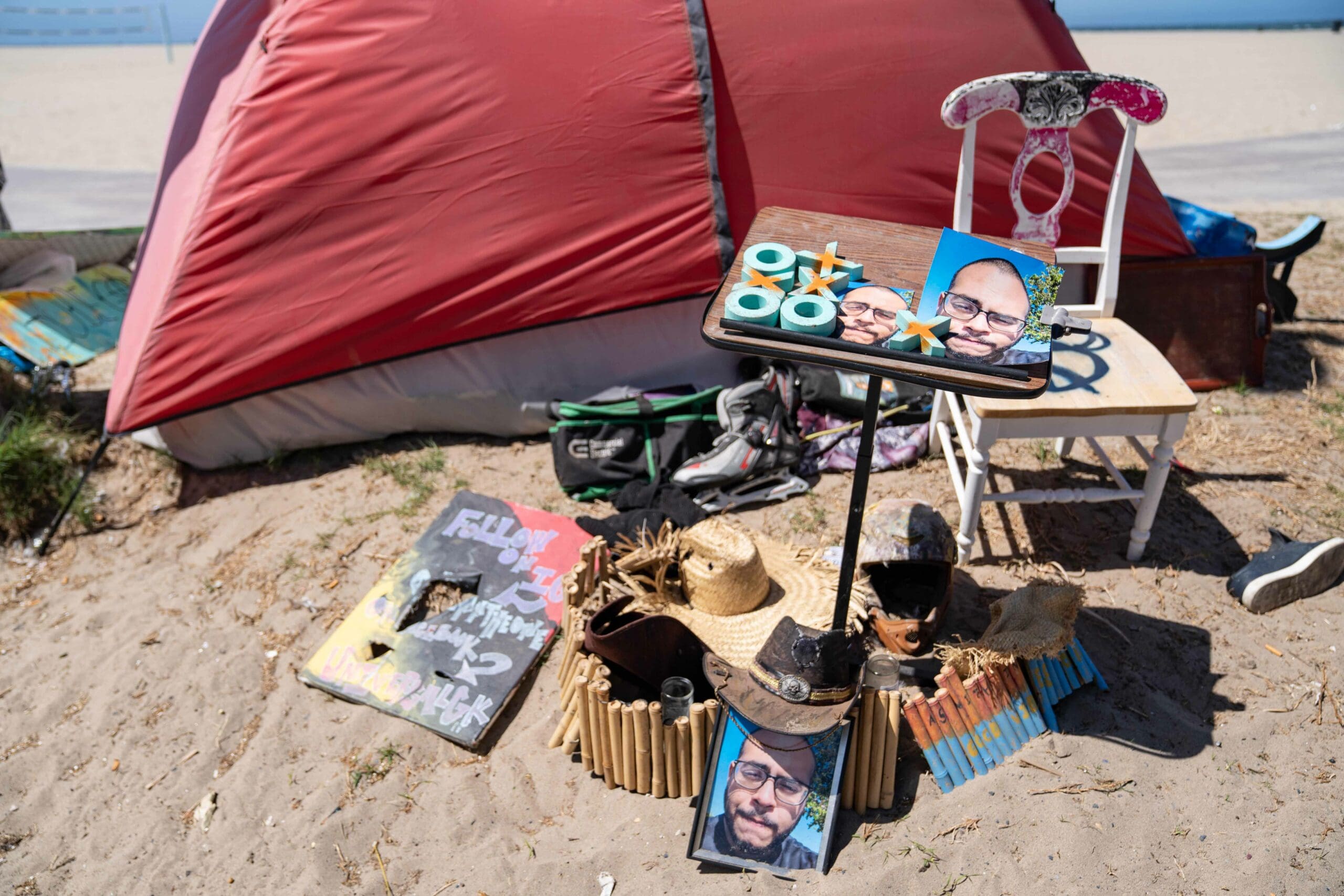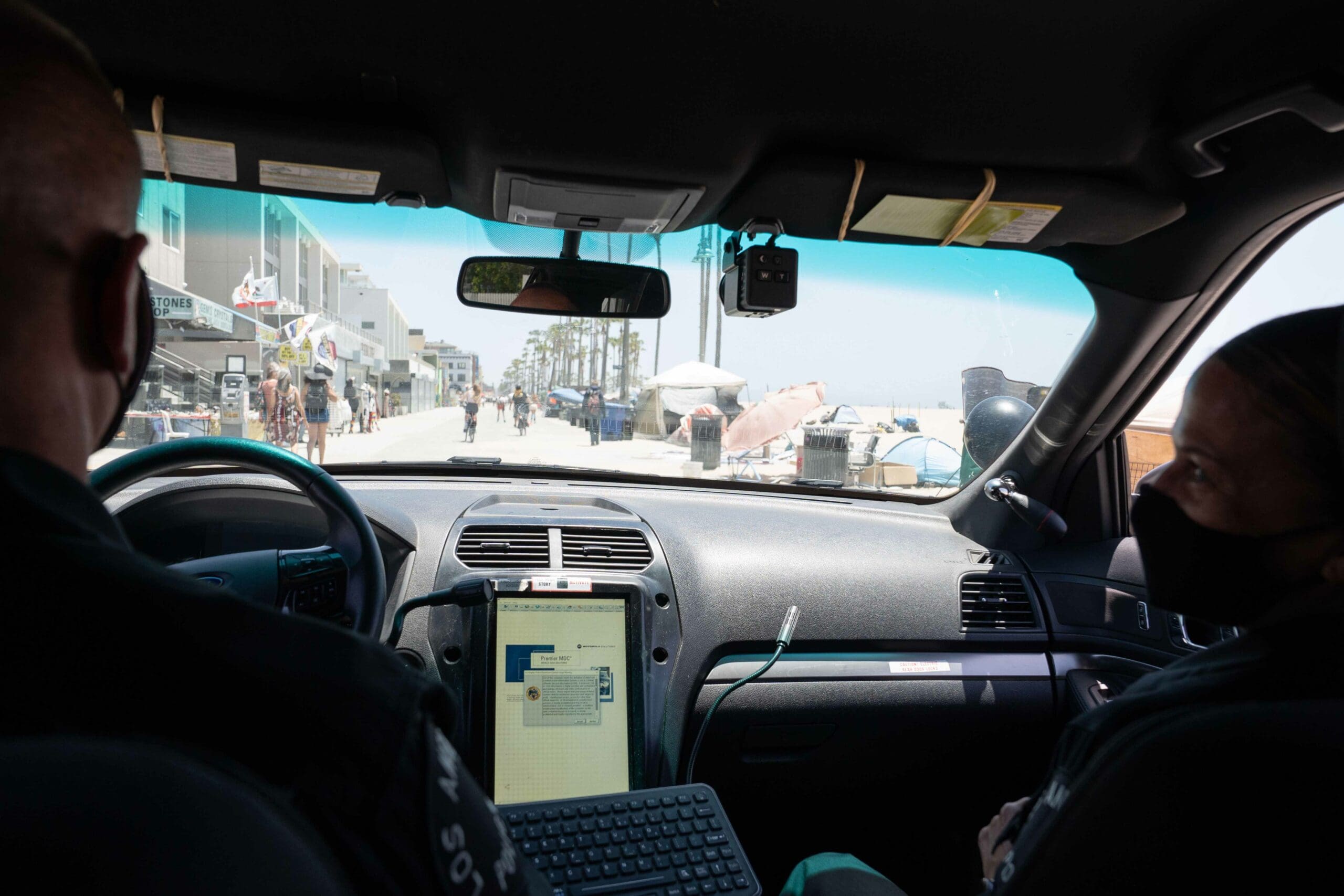Living on Venice Beach: Homelessness, Desperation and Community

Published on
For generations, a carnival-like spectacle has helped draw millions of visitors to the soft sands of Venice Beach — a place second only to Disneyland among Southern California’s tourist sites, according to the Venice Chamber of Commerce.
But a year and a half after COVID-19 touched down in California, Venice’s rough edges are feeling, well, a little rougher — especially to new tenants and homeowners who pay some of the highest rents and housing costs per square foot in the Southland.
People spending millions on nearby homes and stylish offices are often aghast at sporadic violence, visible drug use and the sprawling unhoused masses around them. And they haven’t been alone as the number of robbers and aggravated assaults surged more than 40 percent during the pandemic, according to LAPD data.
L.A. County Sheriff Alex Villanueva has set a Fourth of July deadline for people living on the street to accept services or move away. Otherwise, he says, they will be arrested. He’s promised to target people who are not from California — he wants them to go back to where they came from — and insists that they make up an outsized portion of the unhoused population.
Such points of conflict are not particularly new to Venice, even if there is a question of scale as Los Angeles emerges from the worst of the pandemic and heads into what may be a long, hot summer.
A bohemian spirit of coexistence has long reigned on the two-and-a-half-mile pedestrian Ocean Front Walk and the neighborhood around it. The area, launched as a seaside resort in 1904, has been steeped in counterculture since the 1960s. It is hard to think of another oceanfront where Beat poets, street activists and Rastafarians intersected with skate culture, flamboyant weightlifters and trash-talking basketball players. Vietnam War and Iraq War veterans have long wandered among or slept on the ground near curious Angelenos and wide-eyed Midwestern tourists.
In the 1980s, homelessness increased, fueled by the federal government’s closure of psychiatric hospitals, and many former patients ended up on or around the beach, where they often found a degree of acceptance in the mild weather and within the post-hippie vibe. And other people from around the country followed.
Some inherent tensions, like the clouds of marijuana, have been there for decades, and they are part of what draws visitors to the area.
They are not, however, what brought the huge infusion of tech money to “Silicon Beach” or the magnet for most wealthy newer residents. Some such people, as well as some older residents, have had enough and are hoping that authorities will crack down, much as they did on Echo Park.
In January of 2020, the Los Angeles Homeless Services Authority counted more than 66,000 people without homes in L.A. County, with 1,685 of them in Venice. Across the county, Venice is second only to Downtown’s Skid Row in the number of people living on the street.
But that was just before COVID-19 hit California, spurring shutdowns from which the state is only now emerging. Since then, the housing crisis has worsened.
People who had been living transient lives in the shadows suddenly became more visible sleeping in the rough.
Without shelter available for those who need it, responsibility is falling to charitable organizations and residents’ associations. Dr. Coley King, who heads the street medicine teams at the Venice Family Clinic, says that in addition to addiction, many of the homeless people in Venice suffer from intense childhood trauma. As part of the quest for solutions, Dr. King says that in the short term, it is crucial for such people to feel safe when they sleep, and that true solutions will require access to free or affordable lodging. Contrary to what some observers insist, he says, most are open to moving into permanent housing.
This sentiment was echoed by Monique Contreras, the LAPD senior lead officer for Venice Beach. In the past few months, Contreras says she has been able to place only one person in housing because of the bureaucratic process combined with a shortage of beds.
The organizations that work with people on the streets, whether for sanitation or distributing tents, hygiene kits and clothing in Venice, often ask for police support for safety reasons. This pushes the LAPD into the realms of mediation and social work, which officer Jeff Chiantaretto said has led his wife to ask an incisive question: Why is this a police job? (She is not the only one wondering.)
Captain Steve Embrich, the commanding officer of the LAPD Pacific Area, offered a possible answer as he made his way into the police station: “It is a police problem when all other social safety nets have failed.”
Photojournalist Lexie Harrison-Cripps went on a ride-along with officers from the LAPD in May 2021 on behalf of Capital & Main.

People living on Venice Beach often go by a single name. Take Crown (right), 45. He says he has spent 15 years — one third of his life — without a home, and for five of those years, Crown has lived on the beach, where he fixes bicycles and creates artwork, like the painting shown here.
The prospect of leaving the beach makes him fear losing his community. “I’d like to live in a house,” Crown says, “but I don’t want to be by myself.”
The bigger problem, though, is that “the rent is too high.”
Crown’s neighbor is Jay (left), who strums a guitar as the Northern California native explains that “being at the beach is like being part of a family.”
And, as with most families, he acknowledges, relations can be very challenging. In fact, life on the boardwalk might be more like many intersecting families, Crown suggests. “In such a diverse community you have to learn to be patient,” he says. “There can be a mental overload.”
As if on cue, an agitated woman begins to shout, her attention flickering between us and two policemen with whom she is talking. She tells them that Crown has been mean to her today.
A nearby man picking up litter offers advice: “Just ignore her. She doesn’t understand much. She’s invisible to us.”
Behind him, on a table, sits a broken Mac computer. Crown explains that he didn’t know that until after he pulled it out of a dumpster. A man interrupts him with an invitation to a barbecue before he smiles and says goodbye, and walks off toward the sea.

An unhoused boy poses before riding on to chat with friends.

Teresa and her dog, Nacho, are settled on the edge of Venice’s Ocean Front Walk. “There are so many crazies out here,” declares Teresa, a 63-year-old grandmother who also answers to the name “Funky T.”
Despite her nickname, Funky T doesn’t feel like she fits in with the other people who live here. “I don’t hear voices and I am not a people person,” she says.
She suggests she doesn’t understand what is going on inside of them or why they talk to themselves or invisible friends. She also wonders how they obtain their possessions.
Teresa is a fairly recent arrival. She lived with her son until August of 2020, when his house burned down. As she recalls the fire, her eyes well up with tears. Her two other children said they didn’t have space for her and her small dog.
She had a solution in mind. “It was my dream to live on the boardwalk,” she says, “but it’s rough living here.”
Teresa has struggled, particularly as a woman on her own on the beach. “The men pressure you,” she says, “because they don’t behave well in the wild without rules.”

Chanell (right) gives her dog, Loki, water as Dr. Coley King of the Venice Family Clinic checks his mobile patient application for details about her past medical visits. The 34 year old recently suffered a broken bone in her leg when she was hit by a car. She initially rejected treatment, but after some gentle persuasion by Dr. King, she got an X-ray at a local emergency room.
Fifteen years after the program began such street visits, it has 12 prescribing practitioners on nine different teams.

Dr. King describes himself as a “gatekeeper” who helps guide the people he meets to the right specialist or treatment. To do that on Venice Beach, he must establish trust.
When Dr. King offers to be Chanell’s doctor, she smiles and nods. While in jail, she was diagnosed with rheumatoid arthritis that has gone untreated. The condition causes her ankles and other joints to swell.
As she and the doctor discuss treatment options and shelters that might accept her, Chanell explains that living on the streets involves trauma for women without someone to protect them. It translates into stress and anxiety, she says, noting, “Being a female alone sucks.”

Dr. King treats John while other members of the outreach team engage with locals in the background.
“I’m not one of the ones who walks up and down screaming,” said John, 32. But he does admit that he “used to go to the sea and punch the waves in frustration.”
John appears to be deeply frustrated by his lack of control over his mental health, so Dr. King patiently explains different treatment options. John isn’t keen on pills, but Dr. King notes that there are options such as psychiatric treatment via a long-acting injectable antipsychotic drug.
“The nature of mental illness or schizophrenia,” Dr. King later tells me, “is that you are not very organized to remember to take a pill every day at 9 a.m., and you don’t have a place to put it.” There is also the very real possibility that someone will steal it.
But if people take medication for a month that keeps them in a consistent state, they can become more organized and relaxed, the doctor says. That often helps to get them “ready for housing.”
Conceptually, Dr. King says, outreach teams that work in homeless communities need to be aware of the distinct psychological challenges that many such people wrestle with. “Primary care providers who do street medicine have to get a bit better at doing psychiatry,” he explains.

Dr. King talks to Kenneth Nelson, 55, who claims he was a skater for Dogtown Skateboards.
Nelson recently suffered from compartment syndrome in his arm, which typically results in insufficient blood supply to skin tissue. Following hospital treatment, where doctors made an incision in Nelson’s arm, King explains, it is important for him to keep his nails clean to avoid infecting the healing wound.

A team clears trash from the Ocean Front Walk every Friday. But one person’s trash is another person’s treasure, so the cleanup sometimes causes friction with locals who discover that their possessions are being disposed of.
Dr. King says that cleaning crews and tree trimmers are working in a challenging environment where some locals are anxious enough that they heckle medical outreach teams. “There is so much commotion and anger and confusion today,” he says.
A local named John says such an action is OK, “as long as it’s predictable, as long as I have the knowledge to move my sh*t.”
He knows that there is a higher purpose, which is to avoid a health crisis. “We have had hepatitis A outbreaks,” explains Dr. King. “So it’s important to do good sanitation and pick up what truly is trash. But it can be difficult for someone who is suffering from mental illness.”

A man sits amid what appears to be an informal shop on Venice Beach.

The boundaries between trash and art are often blurred, which leads to confusion and hostilities when beach cleanup crews take away possessions that they believe to be junk.

Officer Contreras (right) and her new partner Jeff Chiantaretto drive their patrol car along Ocean Front Walk. Passersby greet them with a wave or thank them for their service.
Contreras is infinitely patient. A 15-year veteran of the force, she knows many people on these streets — the result, she says, of attending “lots of meetings with community members, and endless emails.”
Officer Chiantaretto brings 25 years of experience to their partnership — 19 as a police officer and six as a Marine.

After reports of an alleged multiple perpetrator rape of a homeless woman, Contreras follows an agitated woman going through trash cans in search of food.
The police role includes providing support for the Los Angeles County Department of Health Services (DHS), which can determine the best interests of the woman if she is deemed incapacitated. While Contreras awaits a DHS decision about how to proceed, the woman disappears among the tents along Ocean Front Walk.
The lead officer says that she looks out for lone women who may be particularly vulnerable while unhoused in Venice.
LAPD officers working in the community attend 40 hours of mental health intervention training sessions in which they learn techniques to approach, de-escalate and best speak to people in difficult situations.

Contreras and Chiantaretto visit the nearby parking area between Gold’s Gym and the Pacific Sunset Bridge Home, where a fence is being put up around a parking lot.

On her first day back on patrol after time off, Contreras points out new tents that have sprung up while she was away.

Contreras and Chiantaretto meet with the manager of the Fig Tree restaurant near the north end of Ocean Front Walk.
Sandy, who did not want to give her last name, has managed the Fig Tree since it reopened late last year. Staff at the casual restaurant have faced a raft of problems, including someone stealing food from customers and a jacket from the staff room. Sandy now keeps a baseball bat and pepper spray in the restaurant.
She increasingly has to consider both staff and diners’ safety, in addition to her normal managerial duties. On Mother’s Day, Sandy says, she lost many potential customers after people saw a news report about trouble on the boardwalk and cancelled.
A recovered addict herself, Sandy has been sober for two decades. She believes that stricter laws helped her to get her addiction under control.

Dr. King checks up on Stephen Smith, who is one of the success stories. After months building trust, Dr. King was able to treat Smith’s potentially fatal heart condition and place him in the Bridge Home.
The medical provider says that “sometimes it takes two minutes, sometimes it takes two years” to establish trust. “The pace is important to these people — you can’t rush it.”
Left untreated, Smith’s peripheral arterial disease could cause a stroke. In the Bridge Home he can access regular medical care. Unfortunately, “life expectancy for people living on the streets is around 48 to 52, whereas in California it is usually around 80,” Dr. King explains.
All Photographs by Lexie Harrison-Cripps
Copyright Capital & Main 2021
Co-published by the Social Documentary Network